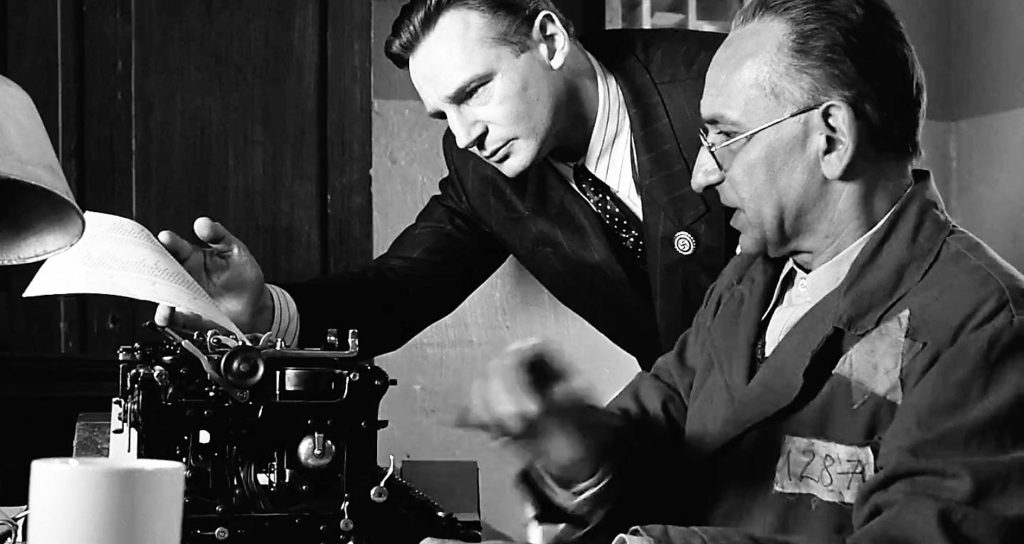
Provoking intense responses both from admirers and detractors, Schindler’s List is the story of a Nazi, Oskar Schindler, who saved more than 1,000 Jews from death. The relationship of mutual gratitude between Schindler and the people he saves is the irreducible element that sets Schindler’s List apart from other chronicles of the Holocaust.
Schindler saves the Jews from the horrors of the Nazi genocide, and he himself is saved also, by emerging—if only partially—from his life of immature, debauched self-indulgence. The Jewish faith is the moral framework within which this world moves and breathes—the dramatic action opens and closes with a Jewish Sabbath prayer, the Kaddish—and Itzhak Stern, Schindler’s business manager, is the silent moral compass and observer, the true hero on whom Schindler leans to understand what he must do, or in one difficult closing scene, how to understand what he has already done.
Grounded in the remarkable historical reality of Schindler’s life, Schindler’s List takes only minor historical liberties. Filmed in black and white, and often relying on hand-held cameras, the experience is immediate and the violence never loses potency or becomes exploitative. Indeed, again and again viewers are required to look deep into the eyes of those about to die, as in one deeply moving scene where the patients of a Jewish hospital drink poison moments before the Nazis would butcher them for being too weak to work.
This humanization is vividly contrasted with the Nazi pogrom’s systematic, bureaucratic slaughter. One Nazi soldier tells Schindler that he bears no ill will to the Jew he unjustly condemned—it’s just that “inconvenience to the list” prevents him from acting. Thus, Schindler ultimately saves “his” Jews the only way a Nazi can: by creating a different list, one that will preserve life instead of cutting it off. It is about names and faces, not numbers; at one point, the Nazi government bunglers take some of his workers to Auschwitz by accident, and offer to replace them with other, healthier workers, but Schindler demands the return of these particular people, the ones on his list.
The melodramatic Hollywood story structure that Schindler’s List strains but never abandons requires a villain who can personify the Nazi moral sickness, and this villain is Amon Goeth. A grown child, Goeth seems not so different from Schindler in superficial ways, but he vacillates between surprising solicitude and cruelty that delights in toys for butchery. There exists no significant check, physical or moral, on his power. He calls Schindler cruel because Schindler offers the Jews hope; in fact, Schindler has learned to treat the Jews with kindness for its own sake, whereas Goeth suppresses his ability to feel compassion via brutal, dispassionate assertions of power.
Schindler’s List looks, at least briefly, at each significant “stage” in the Nazi slaughter, from the internment in ghettos to the work camps to the concentration camps. As such, it is a learning opportunity about the Holocaust for some audiences, and this is at the heart of the controversy that surrounds it. It can be argued that what it is not about (the millions of deaths that make the Holocaust the defining moral horror of the twentieth century) is more significant than what it is about (the saving of a relatively small number of lives).
But Schindler’s List is not the last word on the Holocaust, and we do not deny or diminish the cruel horror of the Holocaust when we raise our eyes to the hope that one man offered to a few condemned people, and that they in turn returned to him.
—David Smedberg (2011)
- Directed by: Steven Spielberg
- Produced by:
- Written by: Steven Zaillian Thomas Keneally
- Music by: John Williams
- Cinematography by: Janusz Kaminski
- Editing by: Michael Kahn
- Release Date: 1993
- Running Time: 195
- Language: English, Hebrew, German, Polish
Arts & Faith Lists:
2004 Top 100 — Unranked List
2005 Top 100 — #49
2006 Top 100 — #41
2011 Top 100 — #90
2020 Top 100 — #87